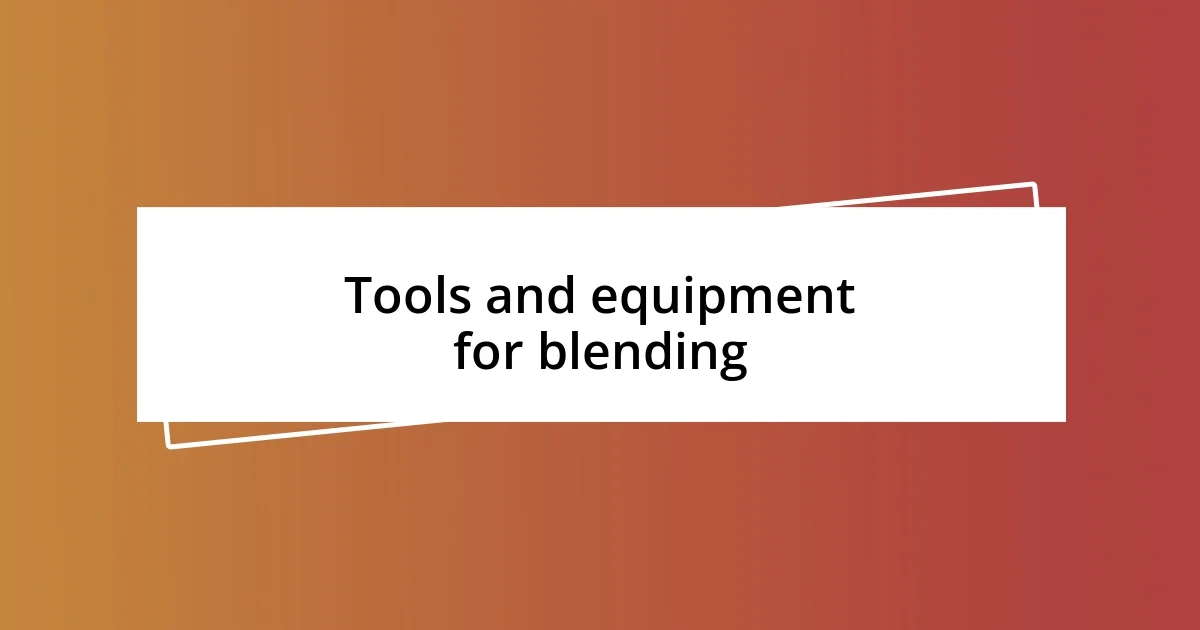Key takeaways:
- The author’s journey with blending transformed from simple curiosity to a therapeutic and creative passion, highlighting the joy and lessons learned through experimentation.
- Understanding blending fundamentals, such as ingredient compatibility, layering, and timing, is crucial for achieving optimal textures and flavors in blends.
- Common mistakes like inadequate prep work, overfilling the blender, and rushing the blending process can lead to unsatisfactory results, emphasizing the importance of careful technique and taste testing.

My journey to blending
The moment I first picked up a blender was quite ordinary, but it sparked an extraordinary passion. I recall experimenting with a simple banana smoothie, and as I combined the flavors, a light-hearted curiosity turned into an obsession. Isn’t it fascinating how something as simple as a kitchen appliance can open up a world of creativity?
As I delved deeper, blending became therapeutic. There were nights when I was overwhelmed by the day, and I found solace in the rhythmic hum of the blender. Each puree and smoothie felt like a small victory, a way of transforming my mood through vibrant flavors. Do you ever feel that sense of peace when you’re lost in a repetitive task?
Through countless trials, I learned the art of not just mixing ingredients, but harmonizing them. I remember a time when I overdid the spices in a vegetable blend, turning my masterpiece into a disaster. The lessons in balance and experimentation are invaluable, making each blending session a new adventure. How has a small mistake turned into a learning moment for you?

Understanding blending fundamentals
Blending is an art that hinges on the understanding of fundamental principles. I learned early on that texture, temperature, and timing play critical roles in achieving that perfect blend. For instance, I recall my first attempt at a greens smoothie. I was so eager that I tossed in cold spinach straight from the fridge, yet still ended up with a chunky, unappetizing mix. It became clear to me that the key is to let ingredients harmonize; for best results, I now always blend the softer fruits first, allowing them to create a base for the more fibrous vegetables.
Here are some essential blending fundamentals to consider:
- Ingredient Compatibility: Certain flavors work better together; understanding this helps avoid clashes.
- Layering Ingredients: Start with liquids, then add softer fruits or veggies, and finish with frozen items for creaminess.
- Timing Control: Blend in intervals to achieve desired textures rather than overprocessing.
- Temperature Awareness: Room temperature ingredients typically blend more easily than cold items.
- Tasting Along the Way: Always taste! Adjust flavors as needed for the perfect balance.
By mastering these basics, I’ve transformed my blending process into a delightful exploration of taste and texture. The journey itself is as rewarding as the final product.

Tools and equipment for blending
The right tools can make all the difference when it comes to mastering blending. I’ve experimented with various blenders, and the experience can truly shape the outcome of your creation. High-speed blenders, for example, are fantastic for achieving silky smooth textures, while immersion blenders offer the flexibility to blend directly in pots or containers. Which one would suit your style of cooking better?
Different tools serve unique purposes. When I first ventured into making nut butters, I realized that a food processor was a crucial addition to my kitchen. The consistency I achieved was far better than any blender could manage. It’s essential to understand the capabilities of each piece of equipment and choose accordingly. Have you ever found that one tool completely changes your approach to cooking?
Lastly, don’t underestimate the power of accessories. A good set of blending cups is invaluable for portioning ingredients or storing leftovers. I still remember the joy of discovering a batch of leftover mango puree that made for a delightful topping weeks later. Investing in quality tools not only enhances your blending journey but opens up creative possibilities.
| Tool | Purpose |
|---|---|
| High-Speed Blender | Ideal for smoothies, soups, and creating creamy textures. |
| Immersion Blender | Perfect for blending soups directly in the pot without transferring. |
| Food Processor | Great for making nut butters, dips, and chopping ingredients. |
| Blending Cups | Helpful for measuring ingredients and storing leftovers. |

Techniques for perfect blending
To achieve perfect blending, I’ve found that ingredient layering is critical. When I start with a base of liquid—often coconut water or almond milk—it creates a smooth environment for softer fruits like bananas to break down easily. Have you ever noticed how adding a splash of liquid transforms a stubborn blend into something silky?
Timing is another technique I’ve honed over the years. Instead of blitzing everything at once, I blend in intervals, giving it a pause to check the texture. I still remember my excitement the first time I pulled a perfectly emulsified dress from the blender; it was a game-changer. I’ve learned that patience in blending not only prevents over-processing but also allows for adjustments while tasting along the way.
Finally, temperature plays a surprisingly vital role in blending success. I now make it a practice to let my ingredients rest at room temperature for a bit. This small adjustment has made a noticeable impact. I recall making a frozen berry smoothie and being met with a lumpy disaster because the ingredients were too cold. Have you experienced something similar? Understanding how warmth can facilitate blending truly changed my approach!

Taste testing and adjustments
I can’t stress enough how essential taste testing is during the blending process. Early on, I learned that not every ingredient plays nicely together. I remember creating a seemingly perfect green smoothie, only to discover it was far too bitter for my taste. This prompted me to add a touch of honey, and voilà—the balance shifted to delightful. Have you ever adjusted a recipe on the fly to avoid a culinary disaster?
Making adjustments isn’t just about flavor; it’s about consistency, too. I often pause to check the texture mid-blending. I vividly recall a time I was blending a spicy salsa, only to find it too chunky. By adding a little extra lime juice, I achieved that perfect saucy consistency that’s irresistible. Has there been a moment when a small tweak made a world of difference in your dish?
I also take notes during these taste-testing sessions. This way, I can replicate successful blends or remember what to avoid next time. Once, after an iteration on a creamy avocado dip, writing down the specific ratios helped me recreate it for friends at a gathering. That experience taught me that blending isn’t just about experimenting; it’s about creating recipes that resonate with both your palate and the people you share them with. How do you keep track of your blending adventures?

Common blending mistakes
It’s easy to overlook the importance of prep work when blending. I remember rushing to make a smoothie, tossing in frozen fruits without cutting them down first. The result? A blender that sounded like it might explode! Not giving ingredients the proper pre-treatment can lead to uneven blends and sometimes even damage your equipment. Have you ever faced a similar blender meltdown?
Another common mistake is overfilling the blender. I’ve had my fair share of explosions—fruit and liquid everywhere! It’s like a mini volcanic eruption. Leaving enough room for everything to move freely is crucial. So, next time you blend, ask yourself: is there enough space for those ingredients to dance together?
Lastly, skimping on the blending time can wreck your results. In the past, I often pulled the mixture too soon, thinking I’d saved time. But oh, did I regret it when I tried to pour out a chunky soup instead of a smooth puree! Taking an extra minute to ensure everything is well-blended can make all the difference. Have you ever been tempted to cut corners, only to wish you hadn’t?














